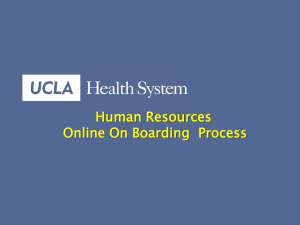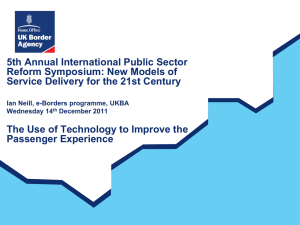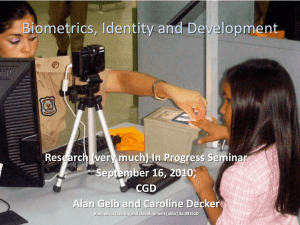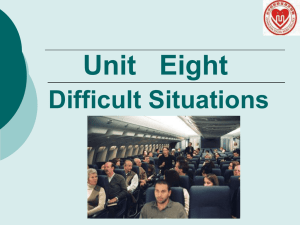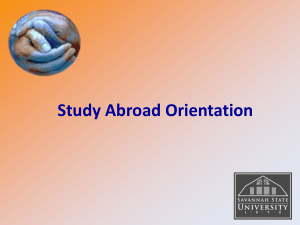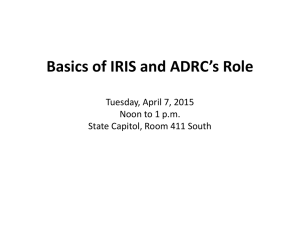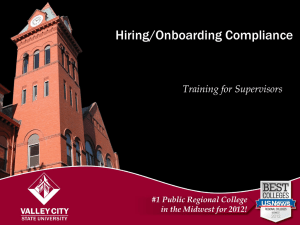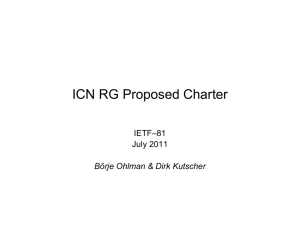NARITA e-check-in - Biometrics TF - 13 July 04
advertisement
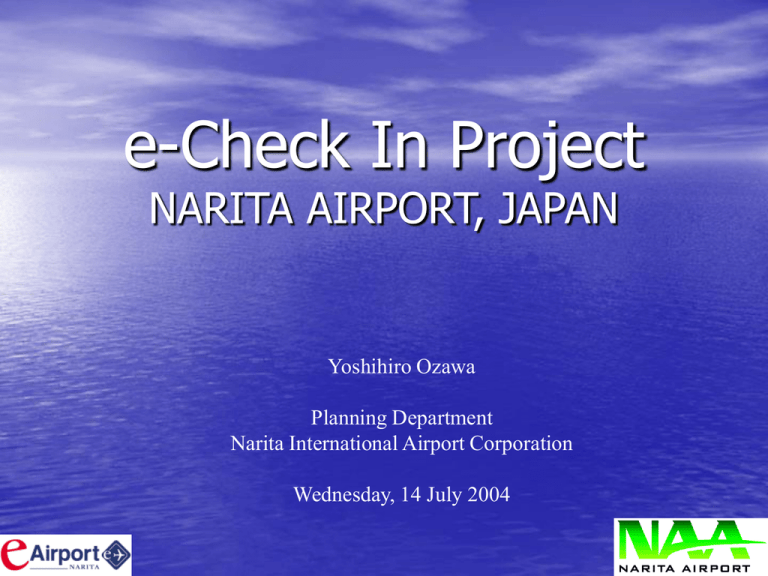
e-Check In Project NARITA AIRPORT, JAPAN Yoshihiro Ozawa Planning Department Narita International Airport Corporation Wednesday, 14 July 2004 e-Japan Program IT Strategy HQ Decision The government and the private sector joined hands in promoting a series of “e” projects launched in 2002. These projects would showcase Japan’s excellence in information technology throughout the country and around the world. One such project is our “e-Airport program” that would allow users to experience the results of IT revolution. e-Airport Project Airport Net Ultra high-speed internet service using optical fiber cable as well as wireless LAN e-Information Integrated real-time public transport, traffic and flight information e-Tag Baggage free travel by using Radio Frequency Identification baggage tags e-Navigation Integrated facility, service and travel information including automated translation service into mobile terminals e-Check-in One stop check-in using biometric technology e-Airport Project Airport Net Ultra high-speed internet service using optical fiber cable as well as wireless LAN e-Information Integrated real-time public transport, traffic and flight information e-Tag Baggage free travel by using Radio Frequency Identification baggage tag e-Navigation Integrated facility, service and travel information including automated translation service into mobile terminals e-Check-in One stop check-in using biometric technology e-Check-in (Integrated support via mobile phones to ease passenger flow) Ticket Gate (Railway) Automatic Check-In Terminal (Airline) Automatic check-in terminals verify identification by passport check and password confirmation, and then write boarding pass and passport information to the IC chip in the passenger’s mobile phone. 特 急 券 上 野 → 成田空港 1月 6日(10:00発) スーパー特急MLT 2号 ¥3,600 1.-1.-6 MLT霞ヶ関IP (11:30着) C12 2号車 1番 B席 禁煙席 (2- ) Biometric data 日本国 旅 券 60153-01 CHECK-IN JAPAN PASSPORT Contactless IC card compatible ticket gates allow commuters to pass through using mobile phones fitted with IC chips. JNS AIR LINES / BUSINESS CLASS MLT 701 /26 Y HONG KONG XXXXXXXXX ご搭乗券 BOARDING PASS 64 56A 0809 ZZ1 XXX MLT 256 56A ZZ1 MLT霞ヶ関店 Limited express train tickets purchased on the Internet, ticket information is sent to the client’s mobile phone and displayed on screen. →No paper tickets required. Security Gate Boarding Gate Tickets and passports are checked using the information registered in the IC chip inside the mobile phone. Biometric data Tickets and passports are checked using the information registered in the IC chip inside the mobile phone. Late passengers are contacted by mobile phone. JNS AIR LINES / BUSINESS CLASS MLT 701 /26 Biometric data Y HONG KONG XXXXXXXXX 64 56A 0809 ZZ1 XXX ご搭乗券 BOARDING PASS MLT 256 56A ZZ1 MLT霞ヶ関店 日本国 旅 券 JAPAN PASSPORT JNS AIR LINES / BUSINESS CLASS MLT 701 /26 Y HONG KONG XXXXXXXXX 64 56A 0809 ZZ1 XXX ご搭乗券 BOARDING PASS MLT 256 56A ZZ1 MLT霞ヶ関店 日本国 旅 券 JAPAN PASSPORT Mr.○○, flight JNS256 is now boarding at Gate 16. Please hurry. JAL-ECKIN Trial Summary • PSGR • Route :JAL FFP* :NRT dep, ICN dep., JAL ope flt • • • • :NRT T2, ICN :Jan04 :Facial, Iris on IC-Card :Interoperability Trial only Location Period Biometrics Rmks •User acceptance of new technology •Operation feasibility study under security enhanced circumstances Interoperability of two systems “Common use IC-chip” is the “interface” between JAL e-CheckIn system and SPEEDGATE System. e-Check In SPEEDGATE e-CheckIn Passport cover with common IC-chip IC chip is securely read/written using PKI technology. PKI server is located in Narita. Registration / Check-in (Narita) Registering equipment For check-in, put the IC card to the equipment and retrieve face data. The system automatically captures the passenger’s face data. Upon matching the face data, the passenger can access to I-SCM (International Self Checkin Machine). Registration center is located in H-island Narita Airport Terminal2. If it is passenger’s first trial, he/she needs to be captured iris and face and make their IC card. Face recognition equipment I-SCM Security Gate (Narita) Priority gate is provided for e-checkin passengers. Before security check point, passenger has to make verification with her/ his iris using this equipment. Boarding Gate (Narita) Priority boarding (same as First and business class) is provided to e-checkin passengers. Before boarding, passenger has to make verification with her/his iris using this equipment. This equipment can be moved to another boarding gate. Registration / Check-in(Incheon) Incheon Registration center for Korean participants is located in J-counter in Incheon International Airport. One SPEEDGATE can make both enrollment and verification. After verification, passenger can proceed to priority check-in counter. SPPEDGATE(ICN) In Narita airport, one SPEEDGATE is available in order to enroll Japanese passenger before Narita departure. SPPEDGATE(NRT) Usage Number (Narita) Passenger Number 2000 1600 1200 800 400 0 Pre registration Check-in(Face) Security(Iris) Boarding(Iris) Properties of participants Number of Departures 1st 6%1% 899 5% Age of participants 284 2nd 3rd 25% 132 4th 65 38% 82 over 5th 0 50 100 150 200 Passenger Numbers 25% 250 0-10 10-20 20-30 30-40 40-50 50-60 60-70 - Some frequent passengers has already enjoyed this trial over 5 times. - Elders and Children have also been enrolled, it took much time to explain for capturing their biometrics. Usage number (Incheon) USER NUMBER 500 400 Pre-registration Check-in(Face/Iris) 300 200 100 0 Japanese customer seems to more interested in biometrics. Biometrics Recognition NRT e-check in system Face recognition rate Recognized Failure 99.1% 0.9% Iris recognition rate Recognized 83.7% Failure 16.3% *2 * Failure ratio is FRR(false rejection ratio) including error case caused by timeout *2 Iris recognition failure rate including 8% passengers who pass the iris recognition, but not going through the correct procedure. - Face recognition at NRT is high. - Iris recognition at NRT is not as good as Face, because some passenger do not see mirror by themselves and end with timeout. It is important to explain to passenger correctly Biometrics Recognition ICN SPEEDGATE system double biometrics concept ‘Face(if failed)Iris’ Face recognition(ICN) Iris recognition(ICN) Recognized 70.3% Recognized 85.8% Failure 29.7% Failure 14.2% Total recognition(ICN) Recognized Failure 95.8% 4.2% = Face failure x Iris failure - Face recognition at ICN is not high by the influence of strong sunlight. (Located near to the curbside) - Total recognition rate is high adopting double biometrics concept. ANA-ECKIN Trial Summary PSGR Route Location Period Biometrics Rmks :e-TKT :NRT dep NH ope flt only :NRT T2 :Dec03 (6months) :Facial :Facial data on BP •User acceptance of new technology •Operation feasibility study under security enhanced circumstances ANA’s ECKIN model Mobile Phones/PDAs/Web Pre-Check IN CKIN Facial recognition Passport Fraud Check 2D bar code Downloaded onto Mobile-phone/WEB PDAs etc. H/J Security check 2D bar code on BP Boarding Gate Facial Recognition Check done by a machine ( facial recognition) Participants 800 300 TTL 714participants From 3Dec-31Mar 700 250 600 200 500 400 150 300 100 200 50 100 0 0 Dec Jan Feb Mar mo. ttl ANA’s Prototype Self Service Unit Camera and Lights 2DBC scanner (Trigger for retrieve Passenger record) Verify photo vs Pax Fraud check PASSPORT Scanner 2DBC on BP Baggage Claim tag issuer Combination with “hand free travel”. 2DBC Boarding Pass Biometrics = ultimate private information Prevent passenger’s anxious feeling = easily understandable way to void data Pax easily see data destroyed. Participants (age) 40% 35% 30% Pax 25% 20% 15% 10% 5% 0% 0~ 20~ 30~ 40~ 50~ 60~ other Recognition Performance Period:03Dec-29Mar 100% FAR not measured Lighting condition affects 80% recognition rate FRR is much higher than expected at Gate area. Not including imperfect enrollments 9.9% 60% 40% 20% 0% 90.1% Failure Success Processing time Procedure Current CKIN Pre-CKIN(off-airport) ECKIN (○) ○ Document check Seat selection ○ ○ Passport read Facial data capture ○ ○ ○ BP issue ○ ○ Time 3 min.(standard) 53.6sec. Participants likes/dislikes(1) Q:Do you mind capturing your face? 4% 0% 27% 21% 8% 40% 1_Not at all 2 3_ave. 4 5_Yes 6 No answer Participants likes/dislikes(2) Q: Would you like to take part this trial again ? 8.2% 1.3% 8.2% 25.1% 23.3% 33.9% 1_abusolutely 2 3_ave. 4 5_No 6 No answer Operator’s comments What is the operational question mostly asked ? How to capture facial picture :46.2% How to scan passport : 30.8% Participants operates smoothly ? Yes smoothly:9.1% Mostly yes: 18.2% OK: 45.5% What is the question asked (not related to participant’s operation) Passport photo vs facial data matching:66.7% Data Privacy security:16.7% Participants comments • Need a better signage where to go ? Where is the machine ? • Need more notification among airport staff(both Airline and H/J Security staff) • Need more previous explanation to participants • Distinguish advantage for participants Don’t understand merit and purpose • Need collaboration with IMM Expedited process is expected • Need better Man-Machine I/F Where to watch during capturing facial data? How long it will take for capturing facial data? Conclusion Improve user I/F Biometrics data capturing Light condition adjustment Trial with “Shade” and research best locating position Coordination with other stakeholder(s) Keep working on additional trial for FY2004 under MoLIT and others Security Thank you www.e-airport.jp www.narita-airport.or.jp/airport_e/
